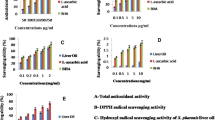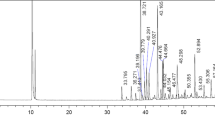Abstract
The physical characteristics such as specific gravity, solidification point, saponification value, iodine, and acid value of liver oil were analyzed, and it has showed good characters similar to fish oil. The heavy metal was found in permissible limit, ash, and moisture was recorded in moderate level, protein, and carbohydrate were found as trace amount; the bad cholesterol was noticed lower and good cholesterol was high than fish oil. Ten fatty acids were recorded, the oleic acid, ω-3, EPA, DHA, and α- linolenic acid were recorded maximum level. The essential and non-essential amino acids were estimated and the fat soluble vitamins (A and E) were noticed higher level. The minerals Zn and Fe were found moderate level. The liver oil has showed antibacterial effect against 7 bacterial strains. The six antioxidant activities of liver oil have showed concentration depended. The Sepioteuthis lessoniana liver oil has showed against A549 cell lines.


Similar content being viewed by others
References
Moovendhan M, Seedevi P, Shanumgam A, Vairamani S (2016) Exploration of the preventive effect of S. lessoniana liver oil on cardiac markers, hematological patterns and lysosomal hydrolases in isoproterenol-induced myocardial infarction in wistar rats: a novel report. RSC Adv 6:64147
Kimura S (1992) Wide distribution of the skin type I collagen α 3 chains in bony fish. Comp Biochem Phys 102:255–260
Shanmugam A, Ramasamy P, Mukesh Kumar B, Saravanan R, Subhapradha N, Vairamani S, Jayalakshmi K (2011) Isolation and characterization of collagen from the skin of Sepia pharaonis (Ehrenberg, 1831). Inter J Current Res 3:107–111
Takaya Y, Uchisawa H, Matsue F, Narumi J, Sasaki J, Iahada KL (1994) An investigation of the antitumour peptidoglycan fraction from the squid ink. Biol Pharm Bull 17:846–851
Rajaganapathi J, Kathiresan K, Singh TP (2000) Purification anti-HIV protein from purple fluid of the sea hare Bursatella leachiide Blainville. J Mar Biotechnol 14:447–453
Gurr MI, Harwood JL, Frayn KN (2002) Lipid biochemistry. Blackwell Science 3:1–4
Luzia AL, Sampaio GR, Castellucci CMN (2003) Torres E.A., The influence of season on the lipid profiles of five commercially important species of Brazilian fish. Food Chem 83:93–97
Dowhan W, Bogdanov K (2002) Functional roles of lipids in membranes. In: Vance DC (ed) Biochemistry of lipids, lipoproteins and membranes, 4th edn. Elsevier, Amsterdam
Anil K, Jayadeep A, Sudhakaran PR (1997) Effect of n-3 fatty acids on VLDL production by hepatocytes is mediated through prostaglandins. Biochem Mol Biol Int 43:1071–1075
Van Vlijmen BJ, Mensink RP, Vant-Hof HB, Oermans RF, Hofker MH, Havekes LM (1998) Effects of dietary fish oil on serum lipids and VLDL kinetics in hyperlipidemic apolipoprotein E3-Leiden transgenic mice. J Lipid Res 39:1181–1187
Folch J, Lees M (1957) Sloane-Stanley G.H., Simple method for isolation and purification of total lipids from animal tissues. J Biol Chem 226:497–507
Bruschweiler H, Dieffenbacher A (1991) Report on the collaborative study. Pure App Chem 63(8):1153–1163
Adeyemo FA (2004) Production, refining of Herring Fish, Chemical Engineering Department, FUT Minna
Abdulkadir M, Abubakar GI, Mohammed A (2010) Production and characterization of oil from fishes. J Engg App Sci 5(7):1–5
AOAC (1984) Official methods of analysis, 11th edn. Association of Official Analytical Chemists, Washington, DC
Lowry OH, Rosenbrough NH, Farr AL, Randall RJ (1951) Protein measurements with folin phenol reagent. J Biol Chem 193:265–275
Dubois M, Giles KA, Hamilton JK, Rebors JK, Smith PA (1956) Calorimetric method for determination of sugar and related substances. Analy J Biol Chem 28:350–356
Yamamoto T, Marcouli PA, Unuma T, Akiama T (1994) Utilization of malt protein flour in fingerprinting rainbow trout diets. J Fish Sci 60:455–460
Sadasivam S, Manickam A (1996) Biochemical methods, II edition, New age international (P) Ltd, Publisher, New Delhi 179–186 pp
Setti PD (1997) Qualitative analysis of drug in pharmacological formulations, 3rd edition pp589–590
Farag RS, Daw ZY, Hevedi FM, El-baroty GSA (1989) Antimicrobial activity of Egyptian species essential oils. J Food Protec 52(9):665–667
Seedevi P, Moovendhan M, Sudharsan S, Vasanthkumar S, Srinivasan A, Vairamani S, Shanmugam A (2015) Structural characterization and bioactivities of sulphated polysaccharide from Monostroma oxyspermum. Int J Biol Macromol 72:1459–1465
Lee JM, Chung H, Chang PS, Lee JH (2007) Development of a method predicting the oxidative stability of edible oils using 2,2- diphenyl-1-picrylhydrazyl (DPPH). Food Chem 103(2):662–669
Halliwell B, Gutteridge JMC, Aruoma OI (1987) The deoxyribose methods: a simple ‘test tube, assay for determination of rate constants for reactions of hydroxyl radicals. Anal Biochem 165:215–219
Dinis TCP, Madeira VMC, Almeida LM (1994) Action of phenolic derivatives (acetaminophen, salicylate, and 5-amino salicylate) as inhibitors of membrane lipid peroxidation and as peroxyl radical scavengers. Arch Biochem Biophy 315:161–169
Freshney RI (2005) Culture of animal cell: a manual of basic technique, 5th edn. Wiley, Hoboken
Siddiqui MA, Singh G, Kashyap MP (2008) Influence of cytotoxic doses of 4-ydroxynonenal on selected neurotransmitter receptors in PC-12 cells. Toxicol In vitro 22:1681–1688
Kiruthika R (2012) Studies on the lipid composition of liver (digestive gland) oil of cuttlefish Sepia prashadi (Winckworth), MSc Thesis Bharathiar University 1–34 pp
Akoh CC, Min DB (2002) Food lipids chemistry, nutrition and biotechnology. In: Shahidi F, Wanasundara PKJPD (eds) Extraction and analysis of lipids. Marcel Dekker, New York (10–1014 pp)
Young FVK (1986) The chemical and physical properties of crude fish oils for refiners and hydrogenators, International association of fish meal manufacturers. Fish Oil Bull 18:1–19
Immanuel G, Menenthira V, Palavesam A, Peter Marian M (2002) Physico-chemical properties and fatty acid profile Odonus niger liver oil. Ind J Fish 49(2):147–153
Paul DK, Rafiquel I, Sattar MA (2013) Physico-chemical studies of Lipids and Nutrient contents of Channa striatus and Channa marulius. Turk J Fish Aquat Sci 13:487–493
Rodriguez RN, de Diego SM, Beltrán S, Jaime I, Sanz MT, Rovira J (2012) Supercritical fluid extraction of fish oil from fish by-products: a comparison with other extraction methods. J Food Eng 109:238–248
Biohaz, (2010) Scientific opinion on fish oil for human consumption, food hygiene, including rancidity. EFSA J 8(10):1874–1877
Sofia V (2012) Reclamation of Loligo devauaceli (Orbigny, 1848) digestive gland (liver) waste for extraction of oil and its composition, MSc Thesis, Bharathiar University 1–39 pp
Kim F, Ford I, Steg PG, Tardif JC, Tendera M, Ferrari R (2014) Ivabradine in stable coronary artery disease without clinical heart failure. New Engl J Med 371:1091–1099
Bharanai P (2012) Extraction and chemical composition of liver (digestive gland) oil from pharaoh cuttlefish Sepia pharaonis (Ehrenberg, 1831). MSc Thesis Bharathiar University 1–31 pp
Gutnikov G (1995) Fatty acid profiles of lipid samples. J Chromatogr Biomed Appl 671(1–2):71–89
Joseph SM (2007) Biological effects of feeding cuttlefish liver oil to rats. PhD thesis, Mahatma Gandhi University Kerala 150 pp
Kringstad H, Folkvoed S (1949) The nutritive value of cod roe and cod liver. J Nutr 79:489–502
Villanueva R, Riba J, Capillas CR, Gonzalez AV, Baeta M (2004) Amino acid composition of early stages of cephalopods and effect of amino acid dietary treatments on Octopus vulgaris paralarvae. Aquacul 242(14):455–478
Dean LM (1990) Nutrition and preparation. In: Martin RE, Flick GJ (eds) The seafood industry. Van Nostrand Reinhold, New York (225–267 pp)
Jobling M, Leknes O (2010) Cod liver oil: feed oil influences on fatty acid composition. Aquacult Inter 18:223–230
Mathew M (2010) Biochemical and pharmacological evaluation of liver oils of selected deep sea sharks and chimaeras of the Indian EEZ, PhD Thesis CUSAT 1–500 pp
Chitra Som RS, Radhakrishnan CK (2011) Antibacterial activity of polyunsaturated fatty acids from Sardinella fimbriata and Sardinella longiceps. Ind J Geo Mar Sci 40(5):710–716
Vairamani S (2010) Studies on biochemical composition, polysaccharides and collagen from Sepiella inermis, PhD Thesis, Bharadhidasan University 1–185 pp
Sabeena Farvin KH, Andersen LL, Nielsen HH, Jacobsen C, Jakobsen G, Johansson I, Jessen F (2014) Antioxidant activity of Cod (Gadus morhua) protein hydrolysates: In vitro assays and evaluation in 5% fish oil in-water emulsion. Food Chem 149:326–334
Sellami M, Rebah FB, Gargouri Y, Miled N (2018) Lipid composition and antioxidant activity of liver oils from ray species living in Tunisian coasts. Arab J Chem 11(2):233–239
Kilic E, Özdemir YG, Bolay H, Kelestimur H, Dalkara T (1999) Pinealectomy aggravates and melatonin administration attenuates brain damage in focal ischemia. J Cerebr Blood Flow Metab 19:511–516
Asnaashari M, Farhoosh R, Sharif A (2014) Antioxidant activity of gallic acid and methyl gallate in triacylglycerols of Kilka fish oil and its oil-in-water emulsion. Food Chem 159:439–444
Gordon HM (1990) The mechanism of antioxidant action in vitro. In: Hudson BKF (ed) Food antioxidant. Elsevier Applied Sciences, London (1–48 pp)
Suffness M, Pezzuto JM (1991) Methods in plant biochemistry. Academic Press San Diego l(6): 71–134 pp
Xu S (1991) The methodology of the pharmacology experiments: methods of the experiments of the anticancer medicines, 2nd edn. The People’s Health Press, Beijing (1423–1458 pp)
Fang C, Granci V, Sorg O, Buchegger F, Pichard C, Marc Y, Dupertuis Y (2013) Vitamin E content in fish oil emulsion does not prevent lipoperoxidative effects on human colorectal tumors. Nutrition 29:450–456
Han SW, Sun XJ, Ritzenthaler JD (2009) Fish oil inhibits human lung carcinoma cell growth by suppressing integrin-linked kinase. Mol Cancer Res 7(1):109–117
Iagher F, de Brito Belo SR, Souza WM, Nunes JR, Naliwaiko K, Sassaki GL (2013) Antitumor and anti-cachectic effects of shark liver oil and fish oil: comparison between independent or associative chronic supplementation in Walker 256 tumor-bearing rats. Lipids Health Dis 12:146–155
Yan W, Hunt LA (2001) Interpretation of genotype X environment interaction for winter wheat yield in Ontario. Crop Sci 41:19–25
Acknowledgements
Authors are thankful to the Dean and Director, CAS in Marine Biology, Faculty of Marine Sciences, Annamalai University for providing all necessary facilities and the corresponding author (Dr.MM) thankful to Department of Sciences and Technology, Science and Engineering Research Board (DST-SERB), National Postdoctoral Fellowship (PDF/2017/000881), Government of India for providing financial assistance.
Author information
Authors and Affiliations
Corresponding author
Ethics declarations
Conflict of interest
The authors declare that they have no conflict of interest.
Additional information
Publisher’s note
Springer Nature remains neutral with regard to jurisdictional claims in published maps and institutional affiliations.
Rights and permissions
About this article
Cite this article
Meivelu Moovendhan, Kavisri, M., Vairamani, S. et al. Valorization of cephalopod liver viscera for oil production: chemical characteristics, nutritional profile and pharmacological activities. Biomass Conv. Bioref. 13, 10011–10019 (2023). https://doi.org/10.1007/s13399-021-01650-3
Received:
Revised:
Accepted:
Published:
Issue Date:
DOI: https://doi.org/10.1007/s13399-021-01650-3




